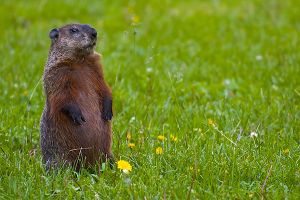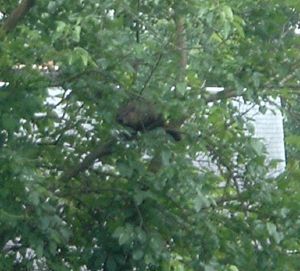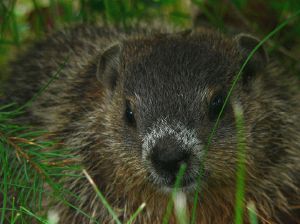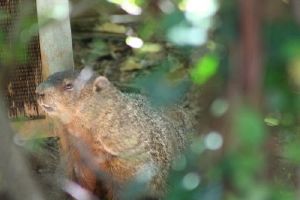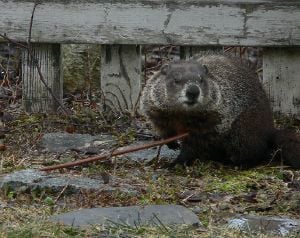Difference between revisions of "Groundhog" - New World Encyclopedia
Rick Swarts (talk | contribs) (added most recent Wikipedia version) |
Rick Swarts (talk | contribs) |
||
| Line 17: | Line 17: | ||
The '''groundhog''' (''Marmota monax''), also known as the '''woodchuck''' or '''whistlepig''', is a [[rodent]] of the family [[Sciuridae]], belonging to the group of large ground [[squirrel]]s known as [[marmot]]s. Most marmots, such as [[Yellow-bellied Marmot|yellow-bellied]] and [[Hoary Marmot|hoary marmots]], live in rocky and mountainous areas, but the woodchuck is a lowland creature. It is widely distributed in [[North America]] and common in the northeastern and central [[United States]]. In the west it is found only in [[Alaska]], [[Alberta]], [[British Columbia]], northern [[Idaho]] and [[Washington]]. | The '''groundhog''' (''Marmota monax''), also known as the '''woodchuck''' or '''whistlepig''', is a [[rodent]] of the family [[Sciuridae]], belonging to the group of large ground [[squirrel]]s known as [[marmot]]s. Most marmots, such as [[Yellow-bellied Marmot|yellow-bellied]] and [[Hoary Marmot|hoary marmots]], live in rocky and mountainous areas, but the woodchuck is a lowland creature. It is widely distributed in [[North America]] and common in the northeastern and central [[United States]]. In the west it is found only in [[Alaska]], [[Alberta]], [[British Columbia]], northern [[Idaho]] and [[Washington]]. | ||
| + | |||
| + | ==Overview== | ||
| + | Marmot is the common name for the stocky, short-legged, diurnal, and typically short-furred and burrowing ground squirrels comprising the genus Marmota of the rodent family Sciuridae (squirrels). Marmots are members of the squirrel family, '''Scuridae''', which also includes [[flying squirrel]]s, [[tree squirrel]]s, and ground squirrels such as the [[#Chipmunk|chipmunk]] and [[#Prairie dog|prairie dog]]. [[Scuridae|Sciurids]], like all [[rodent]]s, are noted for their [[tooth|teeth]]. They have a pair of large incisors on the upper and one on the lower jaw that grow continuously and need to be kept short and sharpened by frequent gnawing. | ||
| + | |||
| + | the '''marmots''' are classified as those ground-dwelling squirrels that are members of the genus '''''Marmota''''' and they are placed in the tribe Marmotini with chipmunks, prairie dogs, and the ground squirrels. The similarly-sized but more social [[prairie dog]] is not classified in the genus ''Marmota'' but in the related genus ''[[Cynomys]]''. | ||
| + | |||
| + | Marmots are generally large [[ground squirrel]]s. The groundhog ''(Marmota monax)'', also known as the woodchuck, is the | ||
== Anatomy and behavior == | == Anatomy and behavior == | ||
| − | The groundhog is the largest [[sciurid]] in its geographical range, typically measuring 40 to 65 | + | The groundhog is the largest [[sciurid]] in its geographical range, typically measuring 40 to 65 centimeters (17 to 26 inches) long (including a 15 centimeter tail) and weighing two to four kilograms (4.5 to nine pounds). In areas with fewer natural predators and large quantities of [[alfalfa]], groundhogs can grow to 80 centimeters (32 inches) and 14 kilograms (30 pounds). |
| + | |||
| + | |||
| + | |||
| + | |||
| + | |||
| + | Groundhogs are well adapted for digging, with short but powerful limbs and curved, thick claws. Unlike other sciurids, the groundhog's spine is curved, more like that of a mole, and the tail is comparably shorter as well – only about one-fourth of body length. Suited to their temperate habitat, groundhogs are covered with two coats of fur: a dense grey undercoat and a longer coat of banded [[guard hair]]s that gives the groundhog its distinctive "frosted" appearance. Like other sciurids, groundhogs have exceptionally dense cerebral bones, allowing them to survive direct blows to the head that would cripple other mammals of the same body mass. | ||
Groundhogs usually live from two to three years, but can live up to six years in the wild, and up to ten in captivity{{fact|date=September 2007}}. Common predators for groundhogs include [[wolf|wolves]], [[coyote]]s, [[bobcat]]s, [[bear]]s, large [[hawk]]s, and [[owl]]s. Humans can eat groundhog, but it is recommended that the scent glands be removed before cooking. Young groundhogs are often at risk for predation by [[snake]]s, which easily enter the burrow. | Groundhogs usually live from two to three years, but can live up to six years in the wild, and up to ten in captivity{{fact|date=September 2007}}. Common predators for groundhogs include [[wolf|wolves]], [[coyote]]s, [[bobcat]]s, [[bear]]s, large [[hawk]]s, and [[owl]]s. Humans can eat groundhog, but it is recommended that the scent glands be removed before cooking. Young groundhogs are often at risk for predation by [[snake]]s, which easily enter the burrow. | ||
Revision as of 15:57, 31 May 2008
For other uses see groundhog (disambiguation) and woodchuck (disambiguation)
| Groundhog / Woodchuck | ||||||||||||||
|---|---|---|---|---|---|---|---|---|---|---|---|---|---|---|
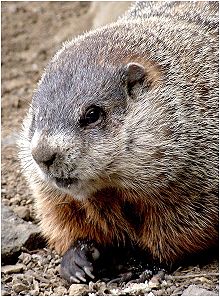 | ||||||||||||||
| Scientific classification | ||||||||||||||
| ||||||||||||||
| Marmota monax (Linnaeus, 1758) |
The groundhog (Marmota monax), also known as the woodchuck or whistlepig, is a rodent of the family Sciuridae, belonging to the group of large ground squirrels known as marmots. Most marmots, such as yellow-bellied and hoary marmots, live in rocky and mountainous areas, but the woodchuck is a lowland creature. It is widely distributed in North America and common in the northeastern and central United States. In the west it is found only in Alaska, Alberta, British Columbia, northern Idaho and Washington.
Overview
Marmot is the common name for the stocky, short-legged, diurnal, and typically short-furred and burrowing ground squirrels comprising the genus Marmota of the rodent family Sciuridae (squirrels). Marmots are members of the squirrel family, Scuridae, which also includes flying squirrels, tree squirrels, and ground squirrels such as the chipmunk and prairie dog. Sciurids, like all rodents, are noted for their teeth. They have a pair of large incisors on the upper and one on the lower jaw that grow continuously and need to be kept short and sharpened by frequent gnawing.
the marmots are classified as those ground-dwelling squirrels that are members of the genus Marmota and they are placed in the tribe Marmotini with chipmunks, prairie dogs, and the ground squirrels. The similarly-sized but more social prairie dog is not classified in the genus Marmota but in the related genus Cynomys.
Marmots are generally large ground squirrels. The groundhog (Marmota monax), also known as the woodchuck, is the
Anatomy and behavior
The groundhog is the largest sciurid in its geographical range, typically measuring 40 to 65 centimeters (17 to 26 inches) long (including a 15 centimeter tail) and weighing two to four kilograms (4.5 to nine pounds). In areas with fewer natural predators and large quantities of alfalfa, groundhogs can grow to 80 centimeters (32 inches) and 14 kilograms (30 pounds).
Groundhogs are well adapted for digging, with short but powerful limbs and curved, thick claws. Unlike other sciurids, the groundhog's spine is curved, more like that of a mole, and the tail is comparably shorter as well – only about one-fourth of body length. Suited to their temperate habitat, groundhogs are covered with two coats of fur: a dense grey undercoat and a longer coat of banded guard hairs that gives the groundhog its distinctive "frosted" appearance. Like other sciurids, groundhogs have exceptionally dense cerebral bones, allowing them to survive direct blows to the head that would cripple other mammals of the same body mass. Groundhogs usually live from two to three years, but can live up to six years in the wild, and up to ten in captivity[citation needed]. Common predators for groundhogs include wolves, coyotes, bobcats, bears, large hawks, and owls. Humans can eat groundhog, but it is recommended that the scent glands be removed before cooking. Young groundhogs are often at risk for predation by snakes, which easily enter the burrow.
Mostly herbivorous, groundhogs primarily eat wild grasses and other vegetation, and berries and agricultural crops when available.[1] Groundhogs also eat grubs, grasshoppers, insects, snails and other small animals, but are not as omnivorous as many other sciurids.
Groundhogs are excellent burrowers, using burrows for sleeping, rearing young, and hibernating. The average groundhog has been estimated to move approximately 1 m³ (35 cubic feet), or 320 kg (700 pounds), of dirt when digging a burrow. Though groundhogs are the most solitary of the marmots, several individuals may occupy the same burrow. Groundhog burrows usually have two to five entrances, providing groundhogs their primary means of escape from predators. Burrows are particularly large, with up to 45 feet of tunnels buried up to 5 feet underground, and can pose a serious threat to agricultural and residential development by damaging farm machinery and even undermining building foundations.[2]
Groundhogs are one of the few species that enter into true hibernation, and often build a separate "winter burrow" for this purpose. This burrow is usually in a wooded or brushy area and is dug below the frost line and remains at a stable temperature well above freezing during the winter months. In most areas, groundhogs hibernate from October to March or April, but in more temperate areas, they may hibernate as little as 3 months.[3] To survive the winter, they are at their maximum weight shortly before entering hibernation. They emerge from hibernation with some remaining body fat to live on until the warmer spring weather produces abundant plant materials for food.
Despite their heavy-bodied appearance, groundhogs are accomplished swimmers and climbers, and climb trees to escape predators or survey their surroundings.[4] They prefer to retreat to their burrows when threatened; if the burrow is invaded, the groundhog tenaciously defends itself with its two large incisors and front claws. Groundhogs are generally agonistic and territorial among their own species, and may skirmish to establish dominance.[1]
Outside their burrow, individuals are alert when not actively feeding. It is common to see one or more nearly-motionless individuals standing erect on their hind feet watching for danger. When alarmed, they use a high-pitched whistle to warn the rest of the colony.[5]
Usually groundhogs breed in their second year, but a small proportion may breed in their first. The breeding season extends from early March to mid- or late April, after hibernation. A mated pair remains in the same den throughout the 28-32 day gestation period. As birth of the young approaches in April or May, the male leaves the den. One litter is produced annually, usually containing 2-6 blind, hairless and helpless young. Young groundhogs are weaned and ready to seek their own dens at five to six weeks of age.
The groundhog prefers open country and the edges of woodland, and it is rarely far from a burrow entrance. Since the clearing of forests provided it with much more suitable habitat, the groundhog population is probably higher now than it was before the arrival of European settlers in North America. Groundhogs are often hunted for sport, which tends to control their numbers. However, their ability to reproduce quickly has tended to mitigate the depopulating effects of sport hunting.[2] As a consequence, the groundhog is a familiar animal to many people in the United States and Canada.
Groundhogs raised in captivity can be socialized relatively easily; however, their aggressive nature can pose problems. Doug Schwartz, a zookeeper and groundhog trainer at the Staten Island Zoo, has been quoted as saying "They’re known for their aggression, so you’re starting from a hard place. [Their] natural impulse is to kill ’em all and let God sort ’em out. You have to work to produce the sweet and cuddly."[6]
Popular culture
In the United States and Canada, the yearly Groundhog Day celebration has given the groundhog some added recognition and popularity, as has the movie of the same name.
In Disney's fictional universe, The Junior Woodchucks are the Boy Scouts of America-like child organization.
The etymology of the name woodchuck is unrelated to wood or chucking. It stems from an Algonquian name for the animal (possibly Narragansett), wuchak. The apparent relationship between the two words has led to the common tongue twister: "How much wood would a woodchuck chuck if a woodchuck could chuck wood? — A woodchuck would chuck as much wood as he could if a woodchuck could chuck wood". Other response lines can be used, including:
- "As much wood as a woodchuck would if a woodchuck could chuck wood."[7]
- "A woodchuck would chuck as much wood as a woodchuck could chuck, if a woodchuck could chuck wood."[8]
- "A woodchuck would chuck all the wood, if a woodchuck only could."[9]
In the play and film, "How to Succeed in Business Without Really Trying," the alma mater of Mr. Biggley is "Grand Old Ivy," whose mascot is the Groundhog. Biggley and Finch sing the college fight song, "Grand Old Ivy," which states the Groundhogs' main rival are the Chipmunks.
In advertisements for instant scratch-off tickets from the state lottery of Pennsylvania, an animatronic groundhog named Gus is featured, the self-proclaimed "second most-famous groundhog" in the state.[10]
In Berkeley Breathed's popular comic strip Bloom County, there is a character named Portnoy who eventually is reavealed to be a groundhog, complete with scientific name Marmota Monax. This leads to a brief rejection from his friend Hodge-Podge the rabbit, saying "I don't work with pigs."
During the 2007 Canadian Grand Prix, a groundhog disrupted the practice session of Ralf Schumacher. On race day itself, Anthony Davidson had been running in third until he struck a groundhog, initially thought to be a beaver, which forced him to pit and repair the damage to his front wing. In the weeks leading up the Grand Prix, city officials trapped as many groundhogs as they could around the race course and transported the animals to nearby Ile Ste-Helene.[11]
Notes
- ↑ 1.0 1.1 Whitaker, John O and Hamilton, W J. (1998). Mammals of the Eastern United States. Cornell University Press. ISBN 0801434750.
- ↑ 2.0 2.1 Animal Diversity Web : Marmota monax (University of Michigan Museum of Zoology)
- ↑ Woodchucks in Rhode Island (Rhode Island Department of Environmental Management)
- ↑ Chapman, J.A. and Feldhammer, G.A. (1982). Wild Mammals of North America, Biology, Management, Economics. Johns Hopkins University Press.
- ↑ Hinterland Who's Who ("Canadian Wildlife Service: Mammals: Woodchuck")
- ↑ Andy Newman, Grooming a Weatherman for His TV Debut, and Hoping He Doesn't Bite the Host. New York Times, January 12 2007]
- ↑ Jackie Silberg (2003), The Learning Power of Laughter, Page 23
- ↑ Laura Rountree Smith (1923), Two Hundred Games that Teach, Page 63
- ↑ The Writer's Forum, The Coffee Shop, [1]
- ↑ Pennsylvania Lottery - Benefits Older Pennsylvanians. Every Day
- ↑ Randy Boswell, ""'Beaver' gets all the blame: British driver pins Grand Prix loss on wrong rodent," CanWest News Service (Tuesday, June 12, 2007).
ReferencesISBN links support NWE through referral fees
- Rodent Specialist Group 1996. [2]. 2006 IUCN Red List of Threatened Species., World Conservation Union. Retrieved on 12 May 2006.
- Whitaker, John O. and Hamilton, W J. 1998. Mammals of the Eastern United States. Cornell University Press. ISBN 0801434750.
External links
All links Retrieved December 20, 2007.
Credits
New World Encyclopedia writers and editors rewrote and completed the Wikipedia article in accordance with New World Encyclopedia standards. This article abides by terms of the Creative Commons CC-by-sa 3.0 License (CC-by-sa), which may be used and disseminated with proper attribution. Credit is due under the terms of this license that can reference both the New World Encyclopedia contributors and the selfless volunteer contributors of the Wikimedia Foundation. To cite this article click here for a list of acceptable citing formats.The history of earlier contributions by wikipedians is accessible to researchers here:
The history of this article since it was imported to New World Encyclopedia:
Note: Some restrictions may apply to use of individual images which are separately licensed.

